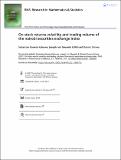On stock returns volatility and trading volume of the nairobi securities exchange index

Date
2021Author
Simwa, Richard O
Mwaniki, Joseph I
Kalovwe, Sebastian K
Metadata
Show full item recordAbstract
This study attempts to put forward a framework that can be utilized to model the dynamics of the underlying returns on asset. The intention is to probe the dynamic connection between volatility of stock returns and trading volume of the Nairobi Securities Exchange (NSE20) index. The consequence of incorporating trading volume in the equation for conditional variance of the generalized autoregressive conditional heteroscedasticity (GARCH) model on volatility persistence is investigated. Further, this study brings into play GARCH, GARCH-M, and EGARCH models conditioned to normal, student-t and generalized error distributions to model the dynamic structure of the NSE20 index for the period 2 January 2001 to 31 December 2017. The results disclose some well-known stylized facts of returns on stock, for instance, volatility clustering, heavy tails, leverage effects, and leptokurtic distribution. The estimates of parameters of the three models, that is, GARCH (1, 1), GARCH-M (1, 1), and EGARCH models report that the correlation between stock returns volatility and trading volume is positive and statistically significant. Moreover, estimates of the coefficients of EGARCH (1, 1) model report an increased measure of persistence on volatility as well as volatility asymmetry and the absence of leverage effect in the returned volatility. Also, the estimates of GARCH (1, 1) and GARCH-M (1, 1) parameters report that volatility persistence dwindles after trading volume is incorporated in the equation for the conditional variance.
